For this assignment four, it was very interesting at how all three drawings results came out. I find doing the preliminary drawing studies and notes with some research on inspiring artists as very helpful tips for this assignment.
For the A1 seated and reclining drawings, I used live models, who were friends of mine and were glad to pose for the assignment drawings.
1. Figure Study using Line (A1) – Seated Model in an Upright Chair.
First I did some look back at my previous studies and research points to collect ideas and inspirations. I came across a line style that I used in previous exercises called Cross Contour Lines, which seems perfect for my final seated pose drawing.
The cross contour line style is an inspiration from “Portrait of the Woman” drawing by Giovanni Boldini, here image link: https://images.fineartamerica.com/images/artworkimages/mediumlarge/2/portrait-of-the-woman-giovanni-boldini.jpg (Accessed 17/10/2020).
You can see my ideas in my A4 sketchbook on page 38, see in Fig. 1 “Look Back Notes, Ideas and Inspirations – A4 Sketchbook, Page 38“, below.
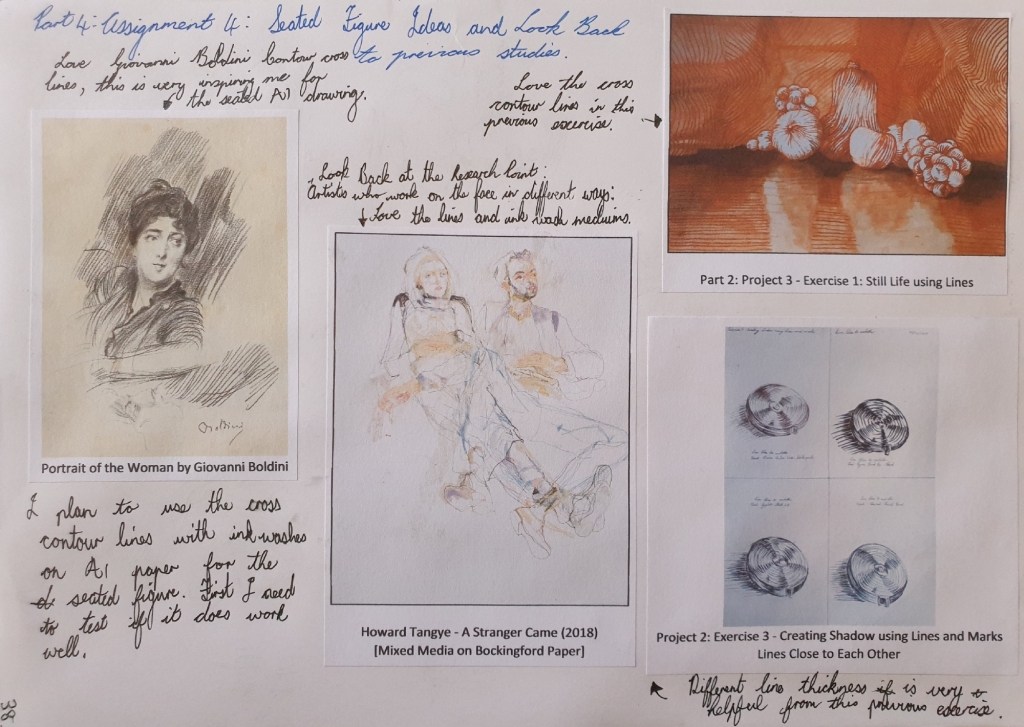
Here is some links from previous studies and researches that I used the ideas and mediums for the final seated drawing.
Part 1: Project 2 – Exercise 3: Creating Shadow using Lines and Marks Link: https://tristanfineart.wordpress.com/2019/02/12/project-2-exercise-3-creating-shadow-using-lines-and-marks/
Part 2: Project 3 – Exercise 1: Still Life using Lines Link: https://tristanfineart.wordpress.com/2019/09/09/part-2-project-3-exercise-1-still-life-using-lines/
Part 4: Project 6: The Head – Research Point – Artists who Work on the Face in Different Ways Link: https://tristanfineart.wordpress.com/2020/09/27/part-4-project-6-the-head-research-point-artists-who-work-on-the-face-in-different-ways/
Preliminary Drawings of Tessa – A4 Sketchbook
I first used my female friend Tessa as the model for the first view preliminary sketches, but then she couldn’t pose for the longer pose for some reasons, so I got my male friend Chad who was willing to pose for the view more preliminary sketches and the final drawing pose.
Here you can see the different line style preliminary drawings of Tessa, below.
First drawing is done with a blue and red colouring pencil in the A4 sketchbook on page 39, see in Fig. 2 “Preliminary Sketch of Tessa – Blue and Red Pencil in A4 Sketchbook, Page 39“, below.
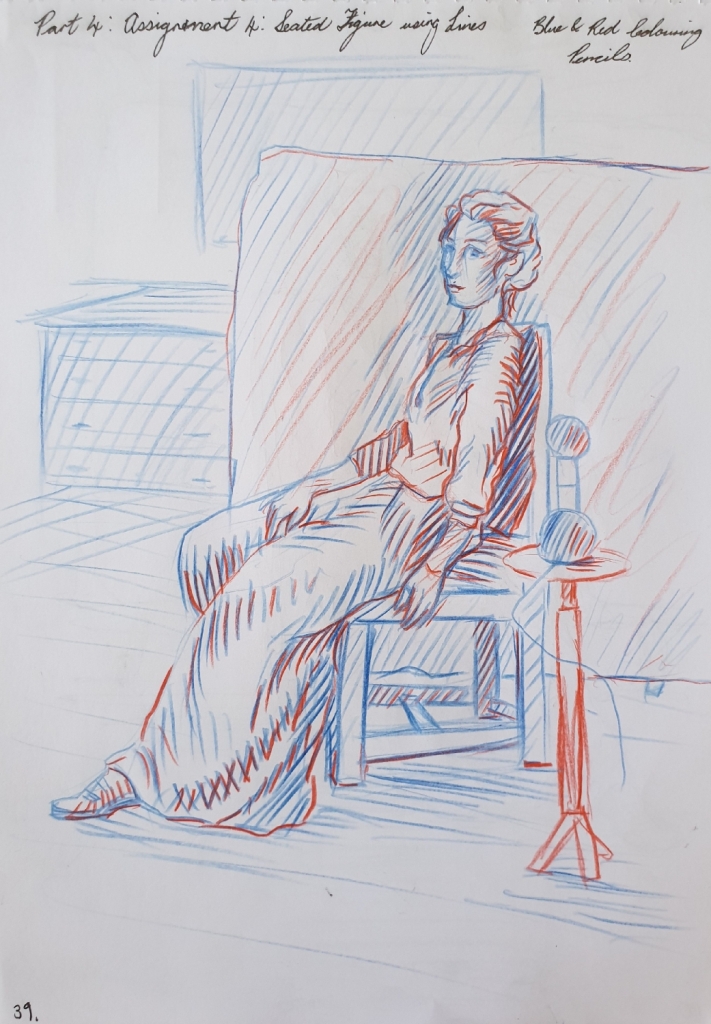
For the second drawing of Tessa, I used black, blue and red gel pens in this drawing. See in Fig. 3 “Preliminary Sketch of Tessa – Blue, Black and Red Gel Pen in A4 Sketchbook, Page 40“, below.

In this final preliminary drawing of Tessa, I used a 2mm graphite clutch 2B pencil in the A4 sketchbook on page 41, see in Fig. 4 “Preliminary Sketch of Tessa – 2mm Graphite Clutch 2B Pencil in A4 Sketchbook, Page 41“, below.

Preliminary Drawings of Chad – A4 Sketchbook
When Tessa couldn’t pose for any longer for some reasons, I managed to have my male friend Chad to pose for the rest of seated preliminary sketches and the final drawing.
First sketch of Chad was done with a black gel pen in the A4 sketchbook on page 42. I love this pose view point as it shows great foreshortening, which I will use the same pose in the final A1 seated drawing. You can see it in Fig. 5 “Preliminary Sketch of Chad – Black Gel Pen in A4 Sketchbook, Page 42“, below.

In the second drawing, I used a black Conte pencil and loved the medium, so looking forward to using it in the A1 final drawing. These show some of the feature areas with using the cross contour lines style. You can see it in Fig. 6 “Preliminary Sketch of Chad – Black Conte Pencil in A4 Sketchbook, Page 43“, below.
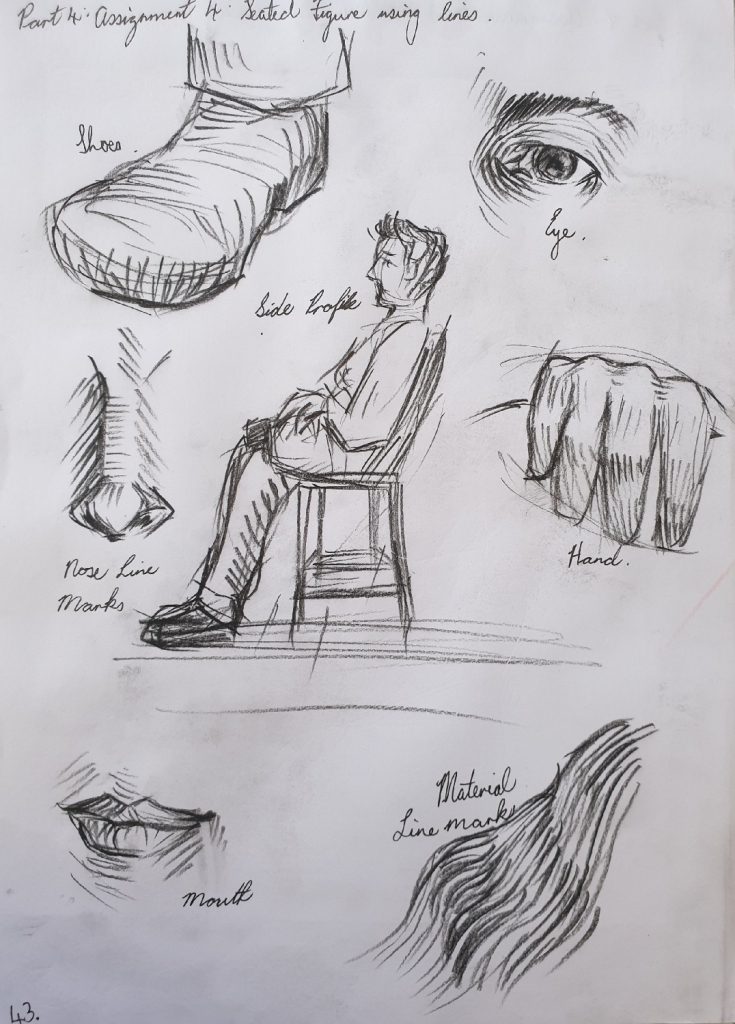
For the final preliminary sketch of Chad, I tried the black Conte pencil with sepia and navy blue acrylic drawing ink washes. I love how these mediums combine together and it shows great expressive feelings. I will be using these mediums in the final A1 drawing. See in Fig. 7 “Preliminary Sketch of Chad – Black Conte Pencil and Ink Wash in A4 Sketchbook, Page 44“, below.
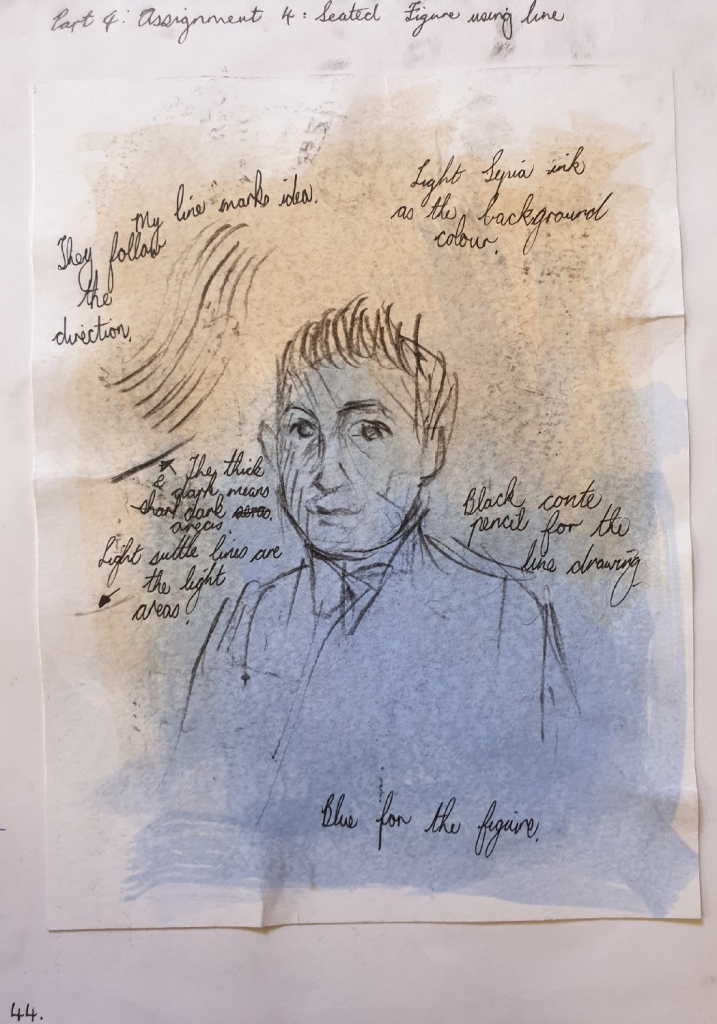
So finishing off with the preliminary drawings and updating my log book with written notes. Then I started on the A1 size final seated drawing of Chad.
Final Drawing (A1) – Seated Model using Lines
For the final drawing, I asked Chad to do the same pose as he did in one of the preliminary sketches as seen in Fig. 5 “Preliminary Sketch of Chad – Black Gel Pen in A4 Sketchbook, Page 42“, but this time, I used the natural sunlight source from the window.
I first painted the sepia and navy blue acrylic drawing ink washes on the A1 white cartridge paper 280gsm, which was mounted to a board. After doing the ink washes, I went to draw in the the big shapes like for example the chair and figure outlines with the black Conte pencil lightly.
After getting the shapes well proportioned, I then went into the figure with cross contour lines with the compression of the black Conte pencil or stick. Wide dark lines are for the shaded areas and light thin lines are the light areas. Bare in mind that my friend Chad is a short height person with a larger face.
Finishing this drawing was the best feeling and I love the outcome results of it, there is so much inspirations and techniques that stand out in this drawing. The way the cross contour lines follow the movement of the material and folds, has really well balanced the atmosphere of Chad’s figure.
There was a stage where I struggled in this drawing, which was trying to avoid of going into details with Chad’s face, because I feared that this drawing would end up as a portrait. But looking at it, all I can see is a seated figure who seems to have been very relaxed and enjoying the conversation that we shared during the 2-hours timeframe.
You can see the final A1 seated Chad using lines in Fig. 8 “Final Drawing of Chad Seated – Black Conte Pencil with Sepia and Navy Blue Ink Washes, A1 White Cartridge Paper, 280gsm“, below.
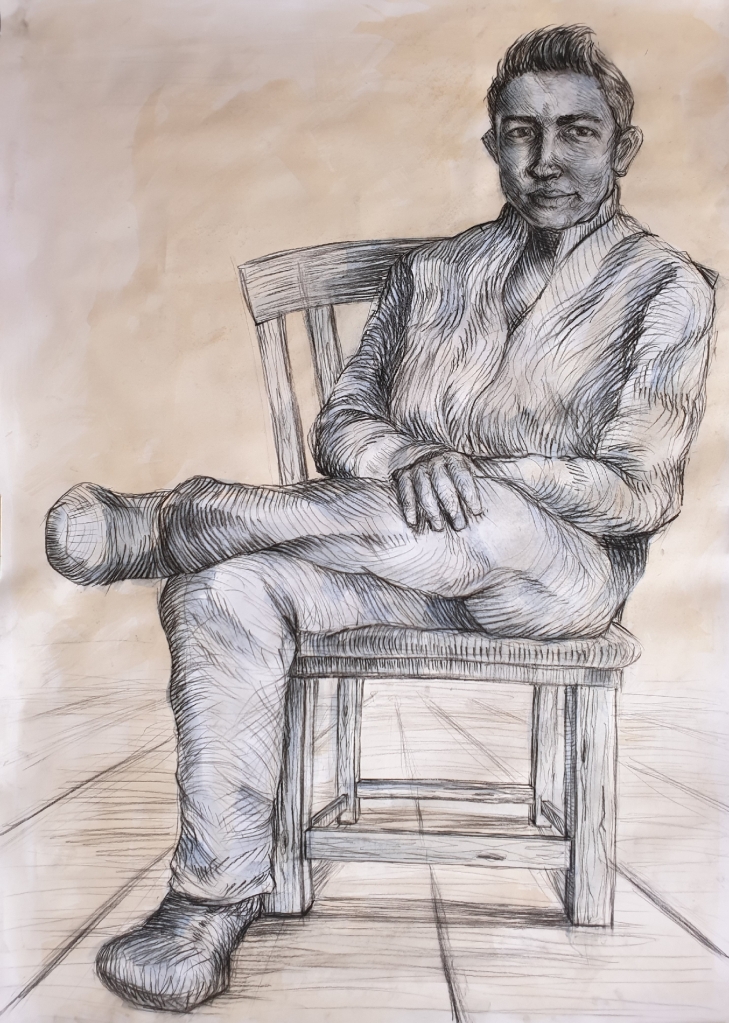
Here is a close up of Chad’s face and torso in Fig. 9 “Final Drawing of Chad, Close Up of the Details – Black Conte Pencil with Sepia and Navy Blue Ink Washes, A1 White Cartridge Paper, 280gsm“, below.
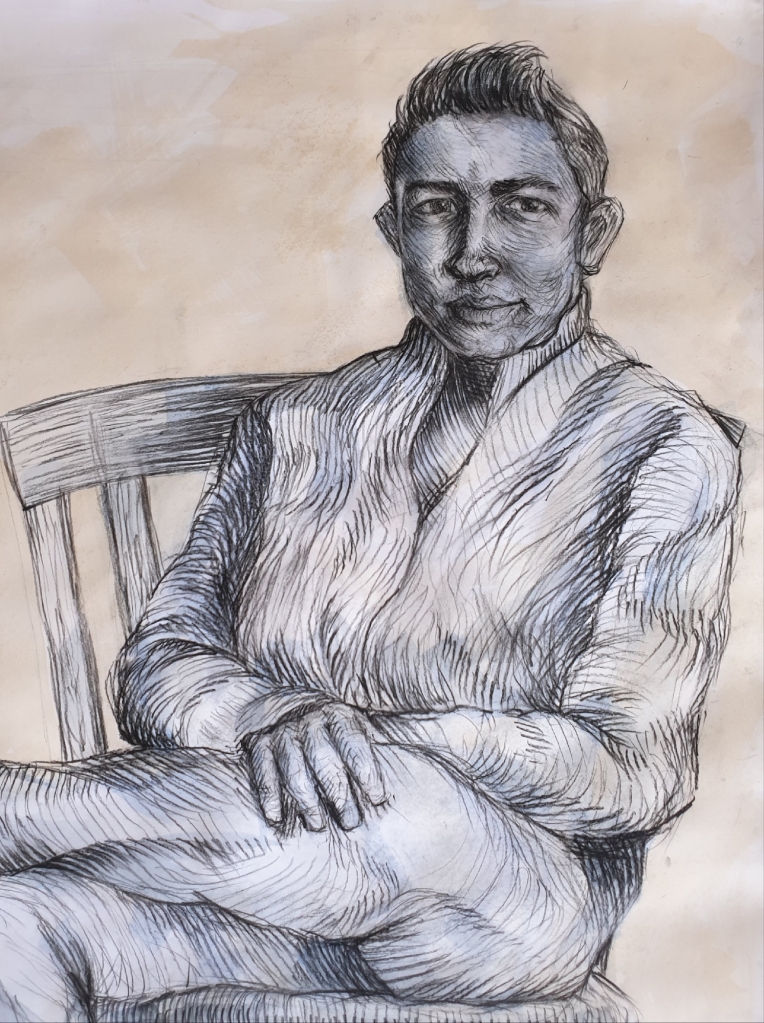
Here is also another close up of Chad’s face details, which gives a clear understanding of the cross contour line mark-makings. See in Fig. 10 “Final Drawing of Chad, Close Up of Face Details – Black Conte Pencil with Sepia and Navy Blue Ink Washes, A1 White Cartridge Paper, 280gsm“, below.
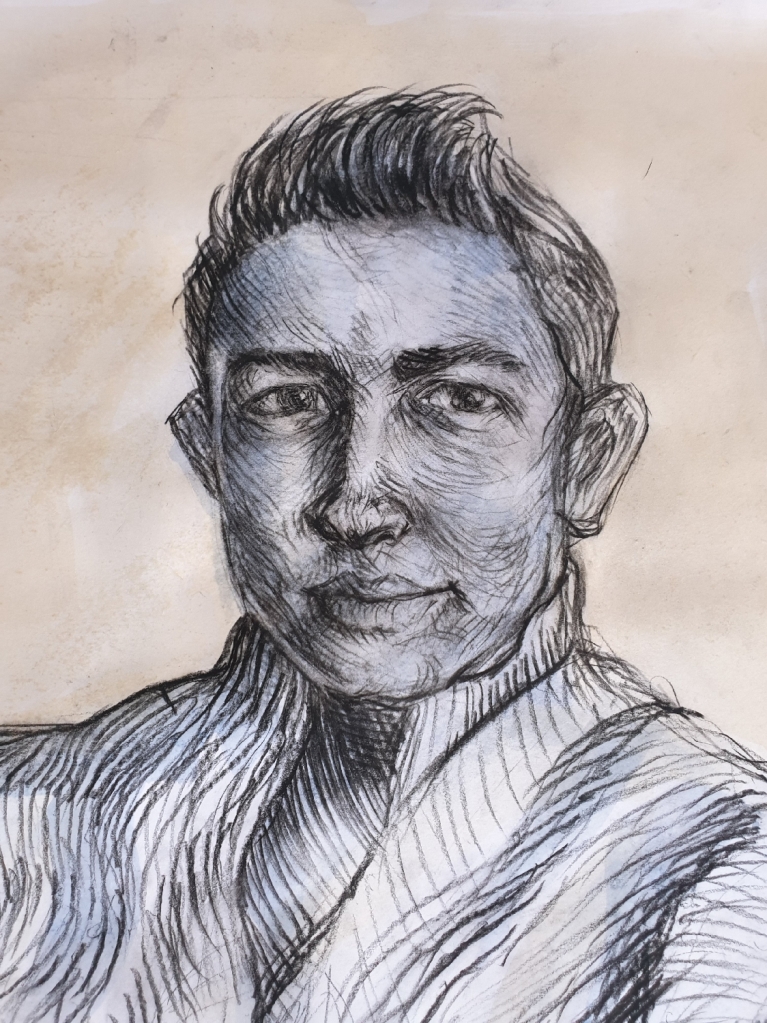
Log Book Notes for the Seated Model using Lines
See in Fig. 11 “Log Book Notes“, below.

2. Figure Study using Tone (A1) – Reclining Model.
For this reclining pose drawing, I used my artist friend Calista to pose for me as she was happy to do so.
I did some look back at my previous studies and research points to collect ideas and inspirational ideas. I found an inspirational artist known for his expressive tonal charcoal drawings, which was Edgar Degas, here you can see a charcoal drawing in the link here: https://dygtyjqp7pi0m.cloudfront.net/i/35689/30744696_1.jpg?v=8D5E8FC771EC0E0 (Accessed 17/10/2020).
You can see my ideas in my A4 sketchbook on page 47, see in Fig. 12 “Look Back Notes, Ideas and Inspirations – A4 Sketchbook, Page 47“, below.
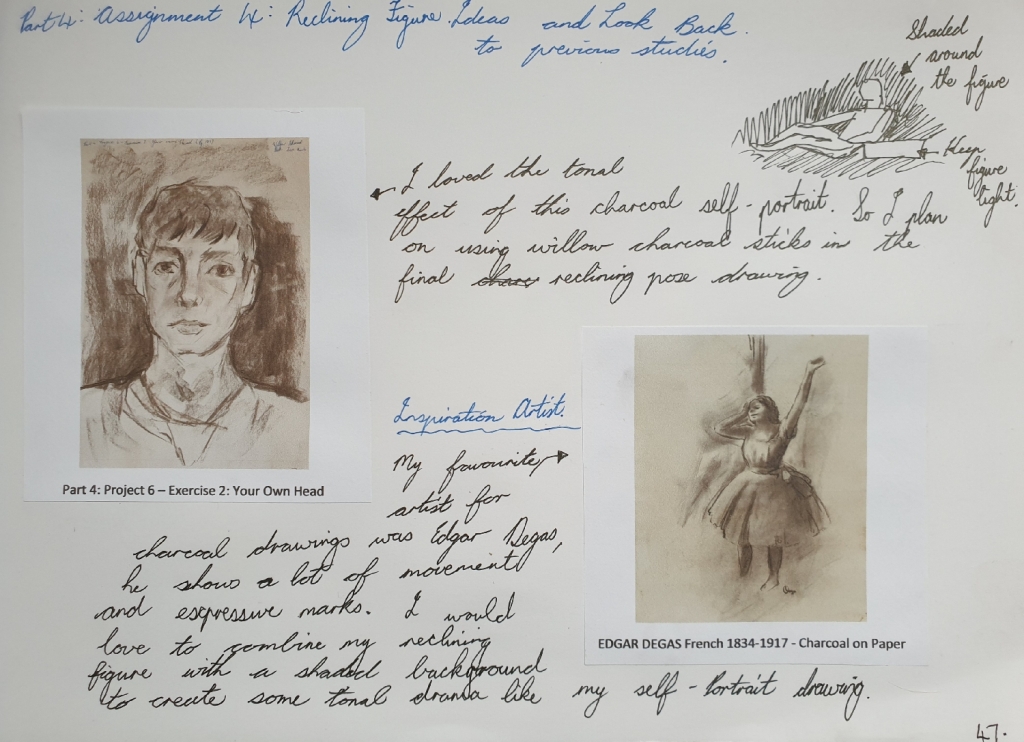
Here is also link from previous study in Part 4: Project 6 – Exercise 2, that I used the charcoal expressive style idea for the final reclining pose drawing.
Part 4: Project 6 – Exercise 2: Your Own Head Link: https://tristanfineart.wordpress.com/2020/10/04/part-4-project-6-exercise-2-your-own-head/
Preliminary Drawings of Reclining Calista – A4 Sketchbook (Page 45)
I did a page in the A4 sketchbook of preliminary sketches of Calista and getting the idea of which view angle will work for the A1 final reclining pose drawing. I also found the willow charcoal stick still the best medium to use for giving great tonal values and expressive marks, which I will use as my final A1 drawing medium.
Here you can see the preliminary sketches in Fig. 13 “Preliminary Sketches – Charcoal Pencil, Black Conte Pencil and Graphite Pencil, A4 Sketchbook, Page 45“, below.

Final Drawing – Calista Reclining Pose
I first had Calista to do a reclining pose, wearing her black pants and light cream jersey, she also was instructed to rest her right arm on a fabric draped cardboard box. The light source came from natural sunlight from the window for this drawing.
I first drew the large body shapes lightly with the willow charcoal stick, then after that I went and blocked in the mid and dark tonal areas by using the flat side of the willow charcoal stick. When finished with using the willow charcoal stick, I then used a putty eraser to lift up the charcoal in some areas where there was some light source shining on, for example the face and jersey.
I love the results of the shaded dramatic tonal background, it makes the figure to be the main attention of the audience. The tonal values are well balanced and seeing this drawing as less detailed information makes it a very interesting reclining subject. Her figure size is well proportioned and her character can be seen clearly as a gentle lady.
You can see the final A1 reclining pose drawing in Fig. 14 “Final Drawing ‘Calista Reclining’ – Willow Charcoal Sticks on A1 White Cartridge Paper, 280gsm“, below.

Here is a close up of the final drawing, see in Fig. 15 “Final Drawing ‘Calista Reclining’ Close Up – Willow Charcoal Sticks on A1 White Cartridge Paper, 280gsm“, below.

Log Book Notes
Here is my written log book notes for the reclining pose drawing, see in Fig. 16 “Log Book Notes“, below.

3. A Portrait or Self-Portrait Combining Line and Tone.
For this part of the assignment, I chose to do a self-portrait, but in a different subject style.
So firstly before I did some look back at my previous studies or researches, this image idea came into my mind and the idea is a triple self-portrait.
The triple portrait idea was an artwork of one of my ancestors by the celebrated artist Sir Thomas Lawrence, who has painted a couple of portraits of my ancestors in his days, so this triple portrait of my family ancestor Emilia Butler, Lady Cahir, later Countess of Glengall (1776-1836) c. 1804-1805, was the inspirational artwork of my childhood. It such an elegant artwork, that looks like a mixed media painting and was done with charcoal, pastel and oil paint.
Painting Link: https://lh3.googleusercontent.com/-R9wIjU0UIFU/TXZywn-CqtI/AAAAAAAAFwQ/SSJKAHTN5as/s1600/2-LAWRENCE_EMILY-COUNTESS-OF-GLENGALL+%25282%2529.JPG (Accessed 17/10/2020).
You can see my written ideas for the self-portrait part of this assignment in Fig. 17 “Look Back Notes, Ideas and Inspirations – A4 Sketchbook, Page 48“, below.
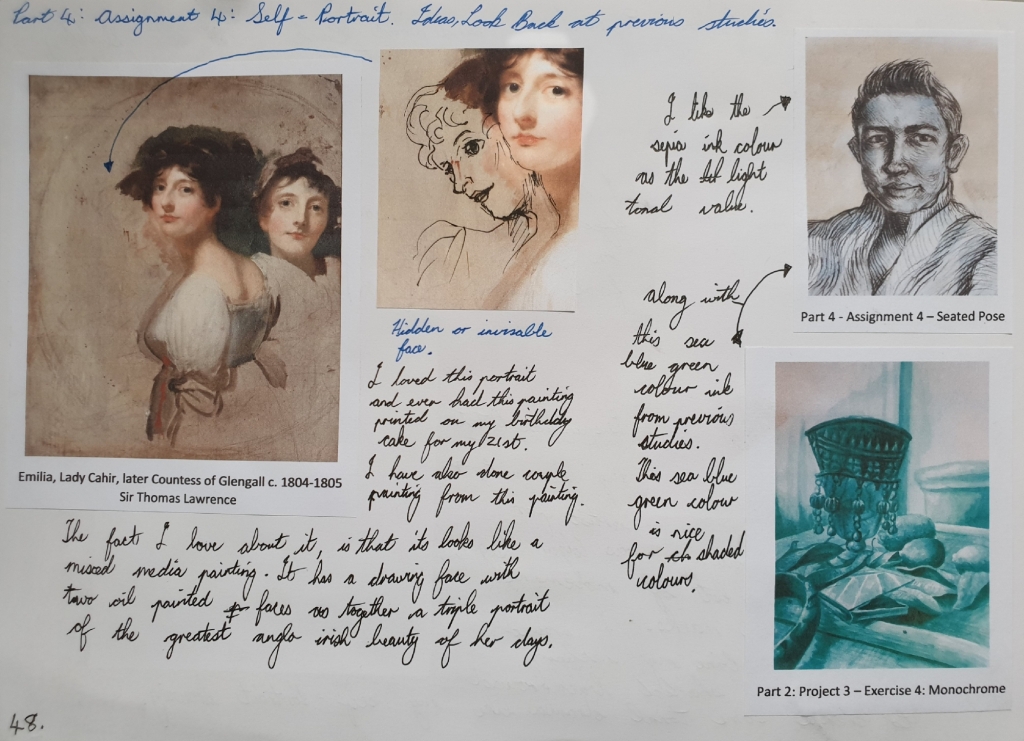
Here is also link from previous study in Part 2: Project 3 – Exercise 4 that I used the sea blue green ink colour idea for the final triple self-portrait drawing.
Part 2: Project 3 – Exercise 4: Monochrome Link: https://tristanfineart.wordpress.com/2019/11/19/part-2-project-3-exercise-4-monochrome/
Preliminary Drawing for Triple Self-Portrait – A4 Sketchbook (Page 46)
I did a preliminary drawing and test on the colours and mediums that are combining together for the final drawing. I plan to use old newsprint paper and tear them up to stick in the background of the triple self-portrait. My chosen ink colours are the sepia for light areas and sea blue green for shadow areas. I also planned on using a graphite 4B pencil and white coal stick for adding highlights on top the dried ink at the end of the drawing.
You can see the preliminary drawing with mediums for the final drawing in Fig. 18 “Preliminary Sketches – A4 Sketchbook, Page 46“, below.
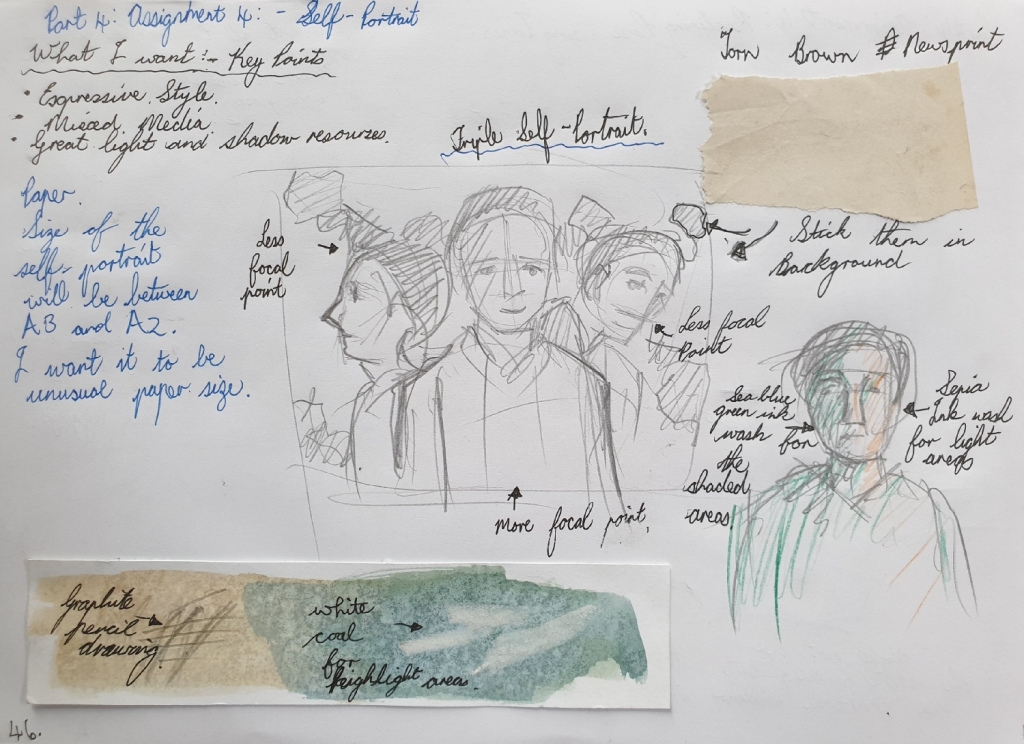
Final Drawing – Triple Self-Portrait
I started drawing the big shapes in like my three faces with the graphite pencil lightly, at the same time I used a mirror to look at while drawing, but I used a photo reference for the side profile face. After drawing in the three face shapes, then next is the overlaying line marks and shading the tonal areas.
After finishing the graphite pencil drawing, I used fixative spray to fixative the graphite medium before going over with the two ink colour washes, sepia for the light areas and sea blue green for the shaded areas. The ink washes create a good sense of feeling, like there is energy exploding from three different directions.
Lastly was the old torn up newsprint paper that I wanted to combine the same colour of Sir Thomas Lawrence’s triple portrait background into my triple self-portrait. But doing the tear up effect in the background makes it more abstract with a twist of old colour.
You can see the final self-portrait drawing in Fig. 19 “Final Self-Portrait Drawing – Graphite Pencil 4B, White Coal, Ink Washes and Torn Up Newsprint Paper on White Cartridge Paper 37 x 58cm, 280gsm“, below.
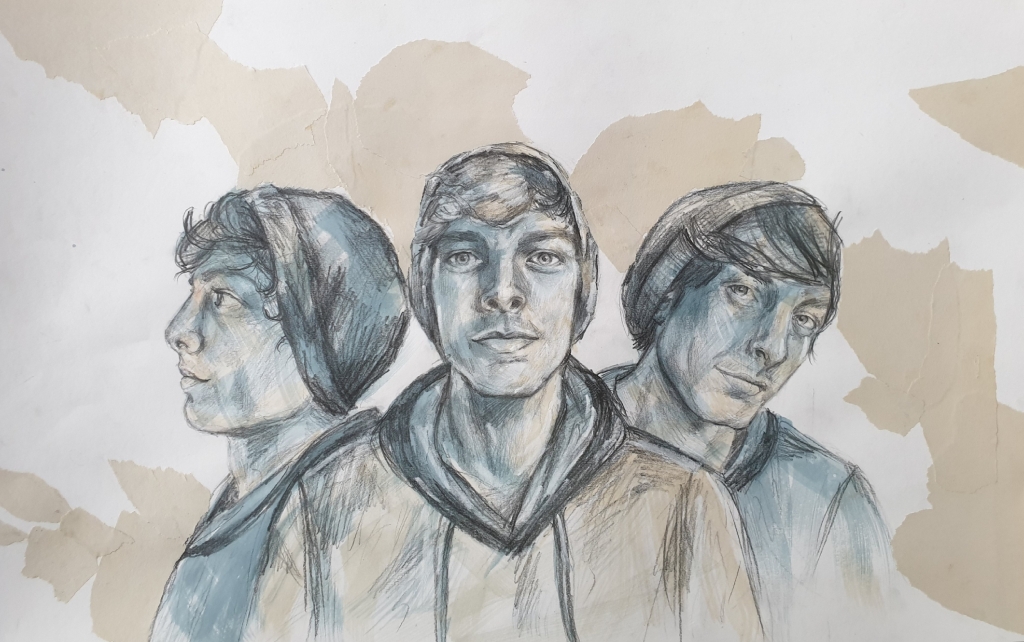
Here is a close up of the looking ahead face from the final triple self-portrait, see in Fig. 20 “Final Self-Portrait Drawing ‘Looking Ahead’ – Graphite Pencil 4B, White Coal, Ink Washes and Torn Up Newsprint Paper on White Cartridge Paper 37 x 58cm, 280gsm“, below.
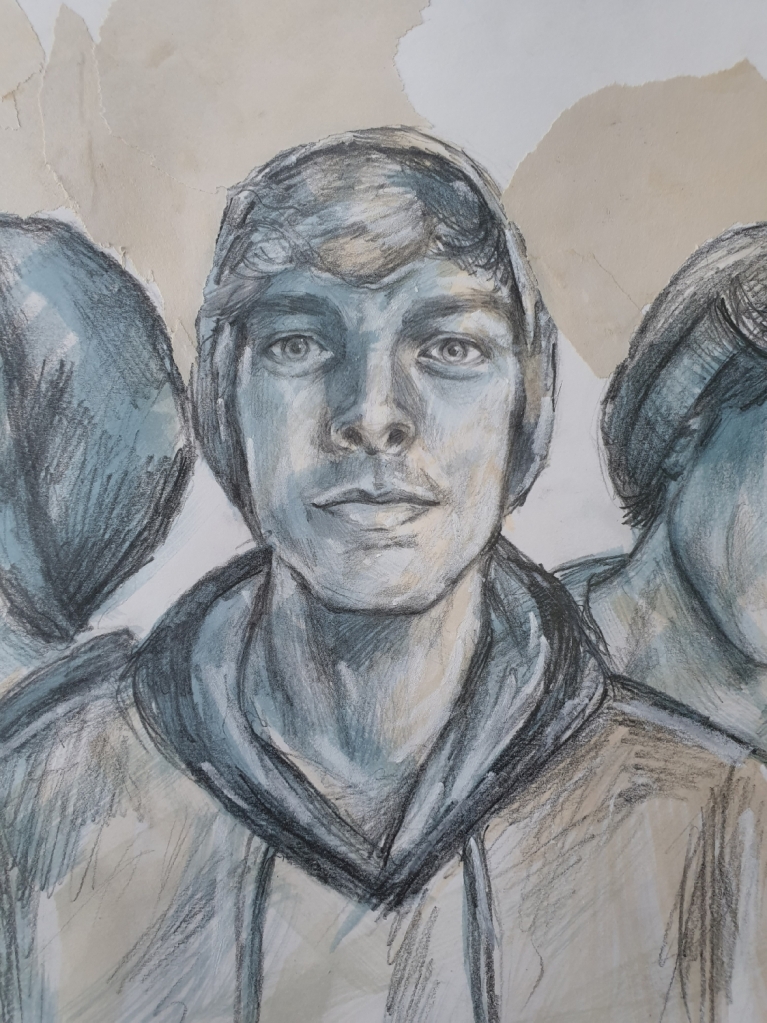
Here is a close up of the slight angle face from the final triple self-portrait, see in Fig. 21 “Final Self-Portrait Drawing ‘Slight Angle’ – Graphite Pencil 4B, White Coal, Ink Washes and Torn Up Newsprint Paper on White Cartridge Paper 37 x 58cm, 280gsm“, below.

Here is a close up of the side profile face from the final triple self-portrait, see in Fig. 22 “Final Self-Portrait Drawing ‘Side Profile’ – Graphite Pencil 4B, White Coal, Ink Washes and Torn Up Newsprint Paper on White Cartridge Paper 37 x 58cm, 280gsm“, below.
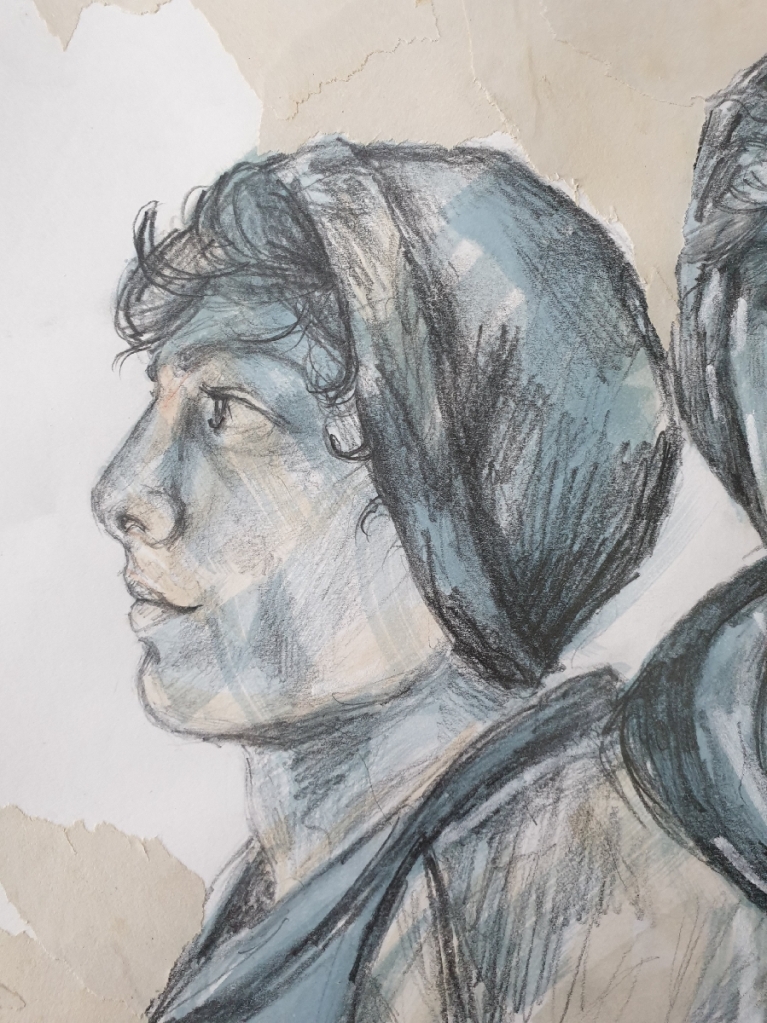
Log Book Notes
Here is my written notes for the triple self-portrait drawing, see in Fig. 23 “Log Book Notes“, below.

Reflection Assessment Criteria
That’s the end of Assignment Four and here is the Drawing 1 – Part 4: Reflection Assessment Criteria Link: https://tristanfineart.wordpress.com/?p=1981

















































